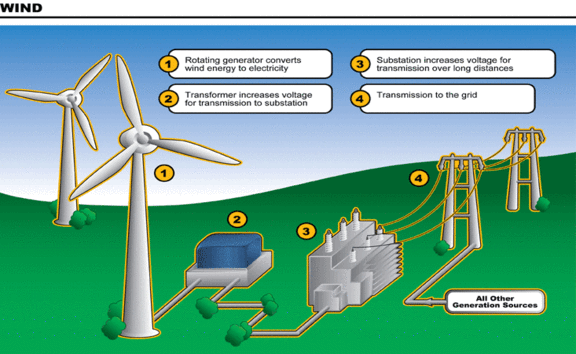
How It Works
HOW WIND ENERGY WORKS
Wind energy is very simple, yet complex at the same time. First off, there are two different types of wind turbines. There are the propeller shaped ones (more common) and vertical ones with curved blades stretching around the outside. First, the anemometer measures wind speed while the wind vane measures its direction. The wind speed data is then sent to the controller, where it decides if there is enough wind or too much wind to operate the system. The winds direction data is then sent to the yaw drive, powered by the yaw motor, to turn to face the winds direction (the vertical turbines do not need these because the blades turn with the wind. The wind then blows through the blade, which are connected to the rotor, to spin fast enough to produce electricity. There is also a gear box connected to a generator to manually force the turbine to spin faster. In case of any emergencies, there is a break mechanism attached to the gear box to stop the blades from spinning. In the final step, the energy produced is sent through a substation and then to the grid where it is sent to homes, businesses, and many other buildings.
How Wind is Created
Wind is created when the air above land heats up faster than the air above water. The warm hair expands and rises. The much more heavy cooler air takes it place, therefore it creates wind. This process is similar to the process of a tornado. Below are two picture diagrams.


The first recorded use of wind power is the Egyptians using the winds to propel their boats down the Nile River. Today, we take advantage of the wind using a little bit more complicated process.
Today's wind turbines use the kinetic energy from the wind and convert it into clean, renewable electricity.
The long process of harnessing wind power starts when the blades catch the wind causing a pocket of low pressure air to form on one side of the blade. The air pocket then pulls the blade towards it, causing the rotor to turn, which is known as lift. The force of the lift is stronger than the force of the wind against the front side of the blade. This is called drag. Both lift and drag working together causes the rotor to spin like a propeller. A series of gears increase the rotation speed of the rotor from about 18 revolutions a minute to about 18,000 revolutions a minute. This speed allows the turbine's generator to produce AC electricity. Next, a nacelle, a streamlined enclosure, houses vital turbine components, which usually consists of gears, the rotor, and the generator. Another important piece of the turbine is the controller. It keeps the rotor speeds from exceeding 55 mph as to avoid damage from high winds. An anemometer constantly measures wind speed and transmits this data to the controller. A brake, also found in the nacelle, stops the rotor mechanically, electrically, or hydraulically if needed.
http://energy.gov/articles/how-wind-turbine-works
Article read by Kiernan

Wind is an extremely clean energy source as it is completely natural, and it doesn’t emit any fossil fuels. However, even though it is natural and does not affect climate change or global warming, it can still affect the population on a different level. The tips of the blades on wind turbines can reach speeds of almost 180 miles per hour at times. This spinning creates low vibrations called infrasound, and disrupts the air pressure. This primary issue can damage the ears of people who live near turbines causing symptoms that include (but not limited to) headaches, sleep problems, ringing in the ears, concentration problems, dizziness, and nausea. Engineers are currently working to fix this issue by building sound-dampening systems. Along with this, they are also setting up a circumference of land around the turbines where residential and commercial buildings will not be able to be built.

